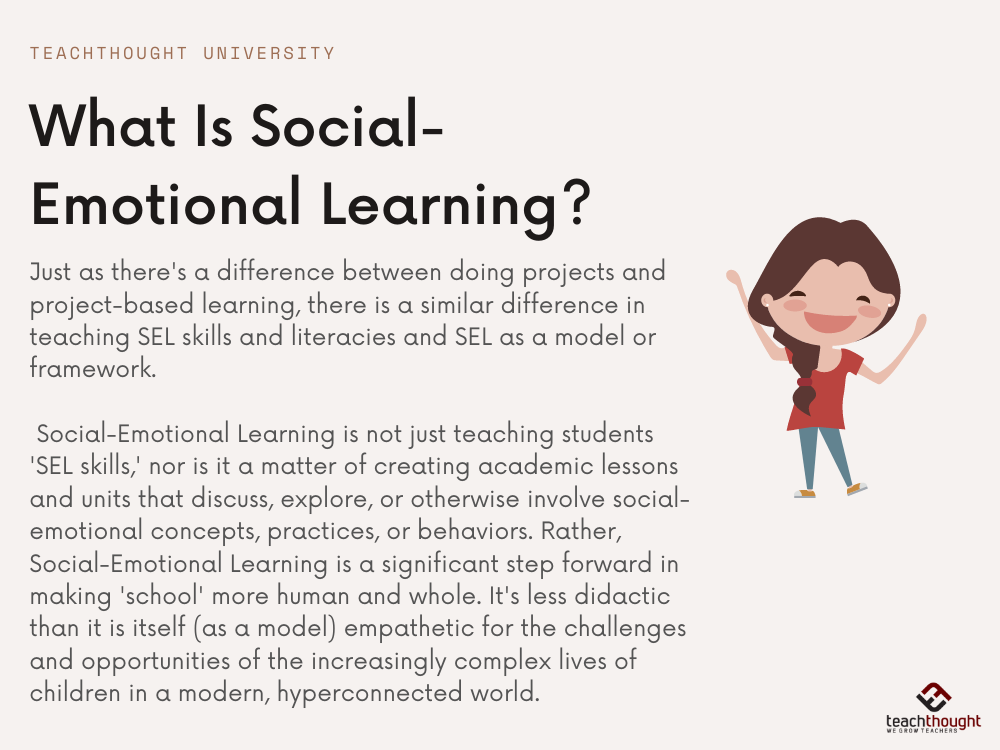
The Definition Of Social Emotional Learning
by Terry Heick
What is Social-Emotional Learning?
Within the context of public education, Social-Emotional Learning is a kind of recognition and slight re-direction of priority, hierarchy, and practice that emphasizes the psychological well-being of the student.
This approach uses resources, strategies, teaching methods, and curricula that both cultivate and take advantage of both emotions and relationships. That is, it both helps promote the ability to think and do things that lead to well-being and healthy relationships while also using the significant presence each of these naturally plays in the lives of students to also promote academic growth.
Like many concepts (and frameworks built with those concepts, as SEL is), there isn’t a single, universal definition for Social-Emotional Learning–nor does there have to be. SEL is a way of thinking about learning that centers (or at least is interested in and adjusts for) emotions and the role they play in well-being while exploring how relationships with others influence emotions and how emotions can, in turn, influence relationships. In effect, SEL recognizes a more complex and ‘full’ (though arguably still not entirely ‘whole’) child into the classroom.
This is a recognition made, in part, by necessity: suffering students who can’t manage healthy relationships or navigate challenges are going to struggle to perform well in school. This is a reversal of previous conventions implied by the design of public education itself where performance in the classroom should lead to ‘performance’ in ‘real life’ (and consequently, well-being).
Social-Emotional Learning, at least in part, suggests that we might consider that well-being (and the role that social interactions and relationships play in that well-being) can lead to growth in school.
Social-Emotional Learning vs Teaching Social-Emotional Learning Skills
Just as there’s a difference between doing projects and project-based learning, there is a similar difference in teaching SEL skills and literacies and SEL as a model or framework.
To clarify, Social-Emotional Learning is not just teaching students ‘SEL skills,’ nor is it a matter of creating academic lessons and units that discuss, explore, or otherwise involve social-emotional concepts, practices, or behaviors. Rather, Social-Emotional Learning is a significant step forward in making ‘school’ more human and whole. It’s less didactic than it is itself (as a model) empathetic for the challenges and opportunities of the increasingly complex lives of children in a modern, hyperconnected world.
Conceptually, this involves ideas like mindset, attitude, cognitive behavior, self-regulation, persistence, empathy, positivity, and rationality.
On a practical level, this involves behaviors like self-monitoring, beliefs about one’s self, setting goals, decision-making, self-care, and the ability to cultivate and maintain healthy relationships with others. Human beings are inherently social organisms (whether by need, instinct, drive, or necessity), and navigating both social interactions and social relationships play a significant role in the well-being of a person over a lifetime (Weissberg & Cascarino, 2013).
See also How Project-Based Learning Can Promote Social-Emotional Learning Skills
The effect of these kinds of ideas and behaviors on academic performance is predictable enough: happy people in healthy relationships embedded in connected communities is conducive to performance in school. This is likely true beyond children and school. As always, there’s the challenge of separating cause from effect but it’s not difficult to imagine that healthy, happy people thrive and people that thrive (in a multidimensional way: in relationships, with their health, financially, etc.) are generally ‘happy.’
Categories Of Social-Emotional Learning
Social-emotional learning (or social-emotional literacy) is the process of building and using social and emotional abilities. In 2015, Roger Weissberg and colleagues identified five categories of social-emotional competencies: self-awareness, self-management, social awareness, relationship skills, and responsible decision-making.
However, other categories obviously exist. Consider the approaches to SEL appropriate for the pre-school classroom and how they might differ from those at the university level. One could also consider framing the concept in terms of a student’s thoughts, feelings, and behaviors and how that student responds to the thoughts, feelings, and behaviors of others.
Physical and digital contexts each have unique nuance within an SEL model. There is also formal and informal SEL, internally-prompted and externally-prompted SEL, SEL for short-term success and SEL for long-term sustainability, urgent and direct SEL (that is responsive to need or trauma) versus passive and indirect SEL (that is general, pre-emptive, and/or ongoing).
Strong Social-Emotional Skills help people–children and adults–see challenges and failures as useful, seek out opportunities, cope with common challenges, and create support systems that lead to success academically, socially, professionally, and within families and relationships.
See also Social-Emotional Learning Resources
Social-Emotional Learning Skills
Social and Emotional Learning (SEL) reflects the critical role of positive relationships and emotional connections in the learning process and helps students develop a range of skills they need for school and life. SEL skills include:
-use of emotions to drive performance (seeking out inspiration as a skill, for example)
-self-regulation
-supportive self-talk (i.e., internal dialogue)
-rational, critical thinking
-flexibility
-relating to and feeling with and for others
-clearly seeing one’s own behaviors and the effects of those behaviors
-resisting blaming and instead seeking understanding
-identifying the ongoing relationship between beliefs, thoughts, behaviors, and feelings (or emotions)
-setting and achieving positive goals
-feeling and showing empathy for others
-establishing and maintaining positive relationships
-making responsible decisions
-meditating or the application of mindfulness
-not automatically attaching to ‘thoughts’ as ‘me’ (separating of self from feelings)
Conclusion
If we truly care about students, then it’s easy to admit that well-being is more important than academic performance. However, as educators, we know that it doesn’t have to be one or the other: we can promote social-emotional health and well-being both because it’s ‘more important’ and because it leads to knowledge gains, confidence development, self-efficacy, and academic progress.
This progress, in turn, can promote self-knowledge, the ability to relate to and collaborate with others, the tendency to seek out satisfying ‘good work‘–which collectively improve the sustainability of that well-being over the course of a lifetime.